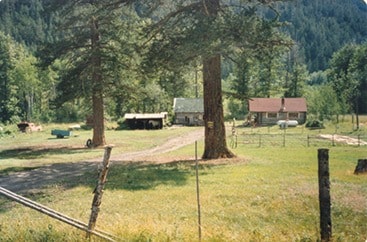It’s an unremarkable house, the sort that most passers-by would barely notice if it weren’t for the fact that houses are scarce on that road, and even the most unremarkable of them attract attention because of their novelty. Its grey, weathered logs and red roof nestle shyly against a backdrop of trees, while a scattering of outbuildings and a fenced-in garden indicate that once upon a time the house was a living thing.
These days, however, the house is a shadow of its former self. Unlived in for many years, it seems to have given up. Every year the porch sags a little bit more, the windows acquire another layer of dust, and it seems to settle into itself, inch by inch, as if hoping that one day it might disappear from sight altogether.
Did I say the house was unlived in? That might not be strictly accurate. There may be no one living there in the conventional sense of the phrase; but that does not necessarily mean nothing lives there. You shall be the judge; I will merely lay the facts before you, as they were told to me.
First we must go back, across a distance of close to four decades. It seemed a throwback even then, with no electricity, but it suited the inhabitants well enough. They were a young couple looking to establish themselves in the area of Oregon Jack, and felt that renting the property – living there, working the land – was a good first step before they could find something more permanent. They weren’t to know that someone else had, perhaps, already decided to be a permanent occupant.
What was the first sign? The flowers, perhaps. The two windows along the front of the house had ledges on the inside, perfect places for accumulating odds and ends and, on occasion, a potted plant that needed a temporary home. One ledge was fine, but there must have been something wrong with the other. Perhaps it had settled, or one of the boards was loose, but plants placed on that ledge had a habit of toppling to the floor at unexpected moments. Nothing else placed on it seemed to come to harm, though; it was as if some very particular occupant had decreed that no plants should go there.
And then there was the bag of flour, which had been left in one spot and was in a very different place, some distance away, a short while later. That was a bit of a head-scratcher, because neither of the people there could remember moving it, but of course we forget all sorts of trivial things we do in a day. Forgetfulness did not, however, explain the tendency of the door to swing open, slowly and steadily, and then stop at just the point where it would be stayed by the hand of someone entering or leaving the house. Even more odd – some might say distressing – was the fact that, after a second or two, the door would close again, as smoothly and quietly as it had opened.
“The wind,” you will say, and that is of course the most sensible answer. If you want to believe that it was merely the wind which opened and closed the door, then you will also want to believe it was the wind which caused the tire swing suspended from a tree in the front yard to swing back and forth, when there was no one within sight of it. And yet I wonder if you would still argue for the wind if you had seen that swing. It was not moving randomly, but rather as if someone were sitting in it. The rope was taut, and the tire moved in ever increasing sweeps – back and forth, back and forth, each sweep a little higher and longer than the one preceding it – for all the world as if someone were inside it, using the momentum of legs and body to urge it on.
“Is that all?” I hear someone ask. Someone always asks this, when I tell the story. That’s because it is, like so many of these tales, not really a story at all: there is no beginning or end, just an inconclusive middle section with more questions than answers. Or perhaps it has answers, and we simply don’t know the questions to ask.
One question I did ask, once, was whether anyone knew anything of previous occupants of the house, and I was told a name – Thelma Haddock – that meant nothing to me. Some years later, however, I encountered Thelma, and thought that perhaps – just perhaps – I’d asked the right question.
It was in a photograph that I saw Thelma, one taken some time just after the turn of the last century. It is a family portrait, taken in front of the Haddock’s house on Brink Street in Ashcroft, and is a conventional picture of its time. Everyone appears somewhat self-conscious and uncomfortable, as if unsure where to look. Everyone, that is, except Thelma.
She is standing at the far right of the picture, gazing straight at the photographer, and by extension the viewer, with a directness – almost a challenge – that is palpable, even a century after the picture was taken. She seems immensely self-possessed, even fearless; someone who knows her own mind, and is determined to take life on her own terms. Thelma lived in the house up Oregon Jack way, and her ashes, I have been told, are scattered in the field behind it. I wonder if she lives there still, and if the old house is quite as empty as it seems.
Barbara Roden
